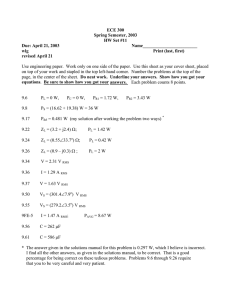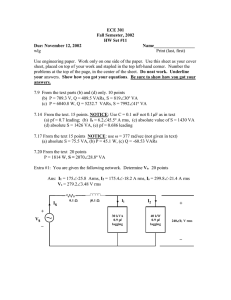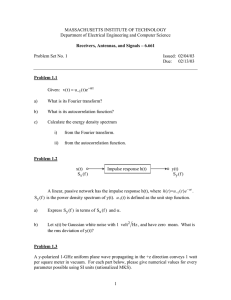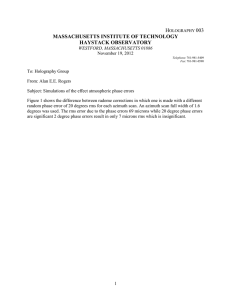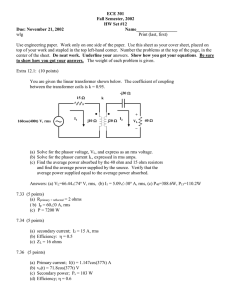Power Measurement (Root Mean Square/RMS)
advertisement
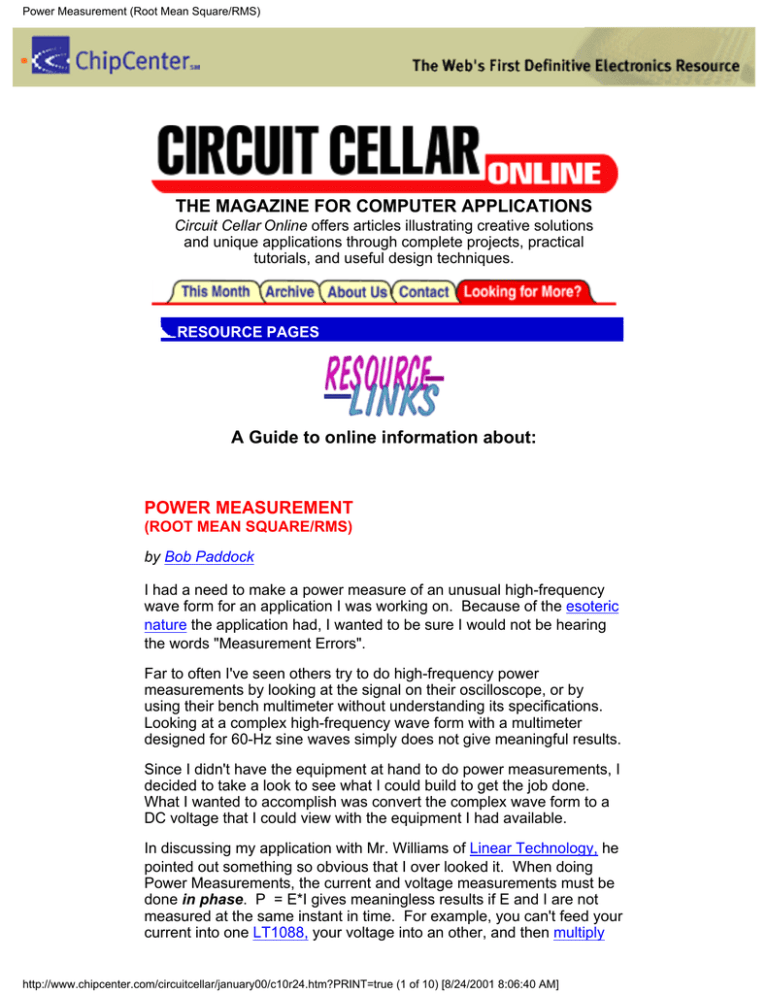
Power Measurement (Root Mean Square/RMS) THE MAGAZINE FOR COMPUTER APPLICATIONS Circuit Cellar Online offers articles illustrating creative solutions and unique applications through complete projects, practical tutorials, and useful design techniques. RESOURCE PAGES A Guide to online information about: POWER MEASUREMENT (ROOT MEAN SQUARE/RMS) by Bob Paddock I had a need to make a power measure of an unusual high-frequency wave form for an application I was working on. Because of the esoteric nature the application had, I wanted to be sure I would not be hearing the words "Measurement Errors". Far to often I've seen others try to do high-frequency power measurements by looking at the signal on their oscilloscope, or by using their bench multimeter without understanding its specifications. Looking at a complex high-frequency wave form with a multimeter designed for 60-Hz sine waves simply does not give meaningful results. Since I didn't have the equipment at hand to do power measurements, I decided to take a look to see what I could build to get the job done. What I wanted to accomplish was convert the complex wave form to a DC voltage that I could view with the equipment I had available. In discussing my application with Mr. Williams of Linear Technology, he pointed out something so obvious that I over looked it. When doing Power Measurements, the current and voltage measurements must be done in phase. P = E*I gives meaningless results if E and I are not measured at the same instant in time. For example, you can't feed your current into one LT1088, your voltage into an other, and then multiply http://www.chipcenter.com/circuitcellar/january00/c10r24.htm?PRINT=true (1 of 10) [8/24/2001 8:06:40 AM] Power Measurement (Root Mean Square/RMS) your results. You must do your E*I before you apply it to the LT1088 input. All of which we'll cover here in more detail, as well as RMS conversion in RF/IF applications. Root Mean Square is a fundamental measurement of the magnitude of an AC signal. The RMS value assigned to an AC signal is the amount of DC required to produce an equivalent amount of heat in the same load. The definitive document on RMS-to-DC conversion is RMS-to-DC Conversion Application Guide, Second Edition, 1986. By Charles Kitchen and Lew Counts, of Analog Devices, Inc. The down side is that it is only available in printed format. It is well worth the effort to track down a copy, perhaps from your library. For example, the Guide gives a clear definition of "Crest Factor", something none of the data sheets do: "The crest factor of a wave form is a ratio of its peak value to its RMS value. Signals such as amplitude symmetrical squarewaves or DC levels have a crest factor of one. Other waveforms, more complex in nature, have higher crest factors." Crest Factor For: Undistorted Sinewave: 1.414 Symetrical Squarewave: 1.00 Undistorted Trianglewave: 1.73 Agilent Test & Measurement has anextremely detailed 26 part tutorial on Measurements and Measurement Errors. For example, True RMS AC Measurements and Crest Factor Errors (non-sinusoidal inputs). Since Analog Devices, Inc. literally wrote the book, you would be correct in your assumption that they have the technology needed to solve your RMS-to-DC conversion problems. Analog Devices Product Index: RMS-to-dc Converters The difference-of-squares function is also used as the basis for a novel rms-to-dc converter shown in Figure 14. The averaging filter is a true integrator, and the loop seeks to zero its input. For this to occur, (VIN)2 – (VOUT)2 = 0 (for signals whose period is well below the averaging time-constant). Hence, VOUT is forced to equal the RMS value of VIN. The absolute accuracy of this technique is very high, at medium frequencies, and for signals near full scale, it is determined http://www.chipcenter.com/circuitcellar/january00/c10r24.htm?PRINT=true (2 of 10) [8/24/2001 8:06:40 AM] Power Measurement (Root Mean Square/RMS) almost entirely by the ratio of the resistors in the inverting amplifier. The AD637 is a complete, high-accuracy, monolithic rms-to-dc converter that computes the true rms value of any complex wave form. It offers performance that is unprecedented in integrated circuit rms-to-dc converters, and comparable to discrete and modular techniques in accuracy, bandwidth, and dynamic range. A crest factor compensation scheme in the AD637 permits measurements of signals with crest factors of up to 10 with less than 1% additional error. The circuit's wide bandwidth permits the measurement of signals up to 600 kHz with inputs of 200 mV rms and up to 8 MHz, when the input levels are above 1 V rms. As with previous monolithic rms converters from Analog Devices, the AD637 has an auxiliary dB output available to the user. The logarithm of the rms output signal is brought out to a separate pin allowing direct dB measurement with a useful range of 60 dB. An externally programmed reference current allows the user to select the 0 dB reference voltage to correspond to any level between 0.1 V and 2.0 V rms. The input circuitry of the AD637 is protected from overload voltages in excess of the supply levels. The inputs will not be damaged by input signals if the supply voltages are lost. The AD737 is a low power, precision, monolithic true rms-to-dc converter. It is laser trimmed to provide a maximum error of ±0.2 mV ±0.3% of reading with sine wave inputs. Furthermore, it maintains high accuracy while measuring a wide range of input waveforms, including variable duty cycle pulses and triac (phase) controlled sine waves. The low cost and small physical size of this converter make it suitable for upgrading the performance of non-rms “precision rectifiers” in many applications. Compared to these circuits, the AD737 offers higher accuracy at equal or lower cost. There is also the AD 736 Low Cost, Low Power, True RMS-to-DC Converter. The AD834 is a monolithic laser-trimmed four-quadrant analog multiplier intended for use in high-frequency applications, having a transconductance bandwidth (RL = 50 W) in excess of 500 MHz from either of the differential voltage inputs. In multiplier modes, the typical http://www.chipcenter.com/circuitcellar/january00/c10r24.htm?PRINT=true (3 of 10) [8/24/2001 8:06:40 AM] Power Measurement (Root Mean Square/RMS) total full-scale error is 0.5%, dependent on the application mode and the external circuitry. Performance is relatively insensitive to temperature and supply variations, because of the use of stable biasing based on a bandgap reference generator and other design features. (Click here for figure) POWER MEASUREMENT (MEAN SQUARE AND RMS) The AD834 is well suited to measurement of average power in high-frequency applications, connected either as a multiplier for the determination of the V x I product, or as a squarer for use with a single input. In these applications, the multiplier is followed by a low-pass filter to extract the long term average value. SECTION 3 RF/IF SUBSYSTEMS of Analog Devices Seminar Series contains several tips and circuits on RMS conversion in RF/IF applications. The AD8361 is a True Power Detection™ (TruPwr™) RFIC, offering RMS-responding power detection for the first time in integrated form. The device is capable of converting a complex modulated RF signal, from 0.1 to 2.5 GHz into a DC voltage representing the RMS level of the signal. The device is highly linear and temperature stable. It is useful for detection of CDMA, QAM, and other complex modulation schemes. "Precise measurement of signal levels is critical to nearly all RF design applications, such as radio links, cellular base stations and wireless terminals, fiber-optic links, instrumentation and test equipment," said John Greichen RF/IF marketing manager, Analog Devices. "In http://www.chipcenter.com/circuitcellar/january00/c10r24.htm?PRINT=true (4 of 10) [8/24/2001 8:06:40 AM] Power Measurement (Root Mean Square/RMS) particular, this innovation solves a major challenge for CDMA and Wideband-CDMA designers. The AD8361 is a revolutionary achievement; a single, low-power IC that simplifies even the most difficult RF signal measurements." A new technology in energy measurement is starting to emerge, with the intention of replacing the 100+ year old mechanical power meters that we are all slaves to. ADI - Energy Meter Solutions Overview. Power Measurement Solutions offers insight into design solutions for integrated power meter ICs, DSP-based systems, discrete solutions, and a detailed reference library. Energy Meter Solutions: SalemTM-3T Overview The SALEM-3T energy meter has been certified for its accuracy by National Physical Laboratory to meet IEC687 standard. The certificate provides results for the meter under various power conditions, including voltage, load, frequency, and power factor. The meter has also been certified by Beijing Test Laboratory, and copies of this certificate are available on request. (Click here for figure) Energy Meter Solutions: ADSST-EM-3010 SALEM-3T Summary: OEMs only have the option of using the chip set, consisting of the Digital Signal Processor + Analog-to-Digital Converter + metering software, to design their own meter using any microcontroller–in http://www.chipcenter.com/circuitcellar/january00/c10r24.htm?PRINT=true (5 of 10) [8/24/2001 8:06:40 AM] Power Measurement (Root Mean Square/RMS) addition to storing various parameters in each Tariff Reg's. The ADSST-EM-3020 has harmonic analysis, which records reactive energy in 2 forms. ADI's Reference Library of Energy Meter Sites can be quite educational. The new Crystal® " power meter on-a-chip" (CS5460) facilitates the transition from widely-used mechanical meters that yield limited data, to electronic meters that provide extensive information on customer energy usage. Furthermore, the new mixed-signal chip outperforms higher-priced electronic meter solutions, often based on costly custom chips or requiring many discrete components. (Click here for figure) Single Phase Bi-Directional Power/Energy IC The CS5460 is a highly integrated DS Analog-to-Digital Converter (ADC), which combines two DS ADCs, high-speed power calculation functions, and a serial interface on a single chip. It is designed to accurately measure and calculate: Energy, Instantaneous Power, IRMS, and VRMS for single phase 2- or 3-wire power meter applications. (Click her for figure) The Fairchild Semiconductor RC4200 analog multiplier has complete compensation for nonlinearity, the primary source of error and distortion. This multiplier also has three onboard operational amplifiers designed specifically for use in multiplier logging circuits. These amplifiers are frequency compensated for optimum AC response in a logging circuit, the heart of a multiplier, and can therefore provide superior AC response. The RC4200 can be used in a wide variety of applications without sacrificing accuracy. Four-quadrant multiplication, two-quadrant division, square rooting, squaring, and RMS conversion can all be easily implemented with predictable accuracy. http://www.chipcenter.com/circuitcellar/january00/c10r24.htm?PRINT=true (6 of 10) [8/24/2001 8:06:41 AM] Power Measurement (Root Mean Square/RMS) Overview of Code-Domain Power, Timing, and Phase Measurements Telecommunications Industry Association standards specify various measurements designed to ensure the compatibility of North American CDMA (code division multiple access) cellular transmitters and receivers. This paper is a tutorial overview of the operation of the measurement algorithms in the HP 83203B CDMA cellular adapter, which is designed to make the base station transmitter Charles Kitchen and Lew Counts, RMS-to-DC Conversion Application measurements specified in the standards, by Raymond A. Birgenheier. US4943764: Wide dynamic range radio-frequency power sensor A wide dynamic range radio-frequency power sensor having, a low-power sensor portion and a high-power sensor portion, is described. Both sensing portions are connected to an input signal at the same time without the use of a signal splitter. In the preferred embodiment, a single radio-frequency load serves both sensor portions. Each sensor portion has its own output terminal. The low-power sensor portion includes a pair of diodes. The high-power sensor portion (which includes the radio-frequency load) may include a pair of diodes preceded by an attenuator, or a pair of thermocouples. Hewlett-Packard Company today introduces the HP E-series E9300 power sensors for the HP EPM series E4418 and E4419 power meters. The HP E9300 sensors can measure the true-average power of RF and microwave signals, regardless of their modulation format, over a wide dynamic range. Engineers can now use a single HP E-series power sensor to measure complex digital-modulation formats–including those used in today's wireless communication, satellite, and cable TV systems–at low and high power levels. The same sensor also measures multi-tone and continuous-wave (CW) signals. This capability allows manufacturers, R&D engineers, and service providers to standardize on one power sensor for all of their average-power measurements, simplifying measurement tasks and minimizing the cost of equipment. Linear Technology has several application notes and parts for RMS conversion based on "first principles" of physics (i.e.; heat). Conversion of AC waveforms to their equivalent DC power value is usually accomplished by either rectifying and averaging or using analog computing methods. Rectification-averaging works only for sinusoidal inputs. A way to achieve wide bandwidth and high crest factor performance is to measure the true power value of the wave form directly. The circuit of Figure 6 does this by measuring the DC heating power of the input wave form. http://www.chipcenter.com/circuitcellar/january00/c10r24.htm?PRINT=true (7 of 10) [8/24/2001 8:06:41 AM] Power Measurement (Root Mean Square/RMS) (Click her for figure) By using thermal techniques to intergrate the input wave form, 50-MHz bandwidth is easily achieved with 2% accuracy. Additionally, because the thermal integrator's output is at a low frequency, no wideband circuitry is required. It is based on measuring the amount of power required to maintain two similar, but thermally decoupled, masses at the same temperature. See Application Note 5 Thermal Techniques in Measurement and Control Circuitry by Jim Williams. From AN5 - "Designers spend much time combating thermal effects in circuitry. The close relationship between temperature and electronic devices is the source of more design headaches than any other consideration. In fact, instead of eliminating or compensating for thermal parasitics in circuits, it is possible to utilize them. In particular, applying thermal techniques to measurement and control circuits allows novel solutions to difficult problems. The most obvious example is temperature control. Familiarity with thermal considerations in temperature control loops permits less obvious, but very useful, thermally based circuits to be built." Linear Technology has converted the above discrete circuit to a monolithic form: LT1088 Wideband RMS-DC Converter Building Block http://www.chipcenter.com/circuitcellar/january00/c10r24.htm?PRINT=true (8 of 10) [8/24/2001 8:06:41 AM] Power Measurement (Root Mean Square/RMS) The LT1088 is a thermally based RMS-DC converter building block. It converts the input wave form to heat. Using external circuitry, the thermal signal is expressed as a DC output voltage. Application Note 22 - A Monolithic IC for 100MHz RMS-DC Conversion. Application Note 67- Linear Technology Magazine Circuit Collection, Volume III Data Conversion, Interface and Signal Processing, compiled by Richard Markell. Application Note 67 is a collection of circuits from the first five years of Linear Technology, targeting data conversion, interface, and signal processing applications. Relevant to our discussion here is the section: WIDEBAND RMS NOISE METER by Mitchell Lee. Shown below is one of the sections of the WIDEBAND RMS NOISE METER. It also shows a very important consideration for this type of circuitry, overload protection. Nothing is more annoying than having your heat-based meter over heat and toast itself to death. (Click her for figure) Design Note 101- A Precision Wideband Current Probe for LCD Backlight Measurement by Jim Williams. Accurate determination of RMS operating current is important for electrical and emissivity efficiency computations and to ensure long lamp life. All product names and logos contained herein are the trademarks of their respective holders. The fact that an item is listed here does not mean we promotes its use for your application. No endorsement of the vendor or product is made or implied. If you would like to add any information on this topic or request a specific topic to be covered, contact Bob Paddock. Circuit Cellar provides up-to-date information for engineers. Visit www.circuitcellar.com for more information and additional articles. ©Circuit Cellar, The Magazine for Computer Applications. Posted with http://www.chipcenter.com/circuitcellar/january00/c10r24.htm?PRINT=true (9 of 10) [8/24/2001 8:06:41 AM] Power Measurement (Root Mean Square/RMS) permission. For subscription information, call (860) 875-2199 or e-mail subscribe@circuitcellar.com About ChipCenter Contact Us Copyright ©1999 ChipCenter Hot Jobs at ChipCenter Privacy Statement Advertising Information http://www.chipcenter.com/circuitcellar/january00/c10r24.htm?PRINT=true (10 of 10) [8/24/2001 8:06:41 AM]
